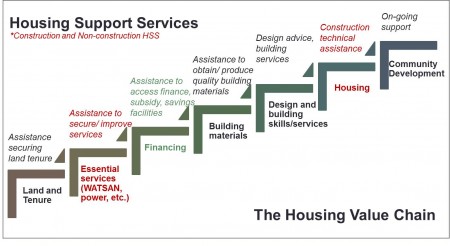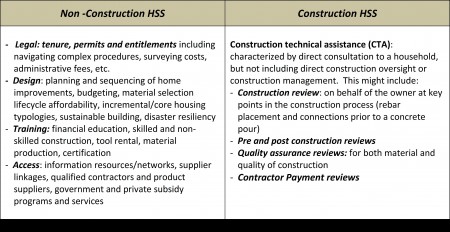Housing Series: The Case for Housing Support Services
(Above: Habitat supports local self-help housing in Pakistan. Image credit: HFHI)
Editor’s Note: The following post is part of NextBillion’s month-long series in partnership with Ashoka focused on affordable housing issues. Please follow the entire series HERE and join the discussion with your thoughts and insights. This is part one of a two-part post. The second post may be found here.
Access to finance and secure tenure has been shown to be the most effective catalysts for self-help incremental housing improvements. But while they are essential, even together, they are not sufficient to improve the living conditions for many of the world’s low-income populations.
- Better access to housing finance would not have changed the devastating impact of the recent Haiti earthquake on the poor. Those who invested in heavy concrete roofs to protect their families from hurricanes were crushed by the earthquake.
- Land rights and secure tenure alone have also proven insufficient to ensure effective housing improvements. Studies suggest that families delay and limit investment in their self-built home improvements when they fear eviction. This has led some in the development community to promote secure tenure as a panacea for catalyzing housing improvements in urban settlements. It has become the new low cost version of the previous Sites and Services [1] strategy that was accompanied by secure tenure.
Nearly half of the population in the developing world live in an urban context; and one-third of them live in informal settlements (830 million). While incremental self-managed housing development has been the principle strategy used by the urban poor to improve their housing, there is a growing recognition that, without adequate access to better information and support, this self-managed approach can not only be more costly and less efficient; it can have devastating consequences with the increasing encroachment and densification on high hazard areas.
In Haiti as elsewhere, lack of land use planning, lack of clear and enforced building codes, a tortured building approval process, poor construction material quality, and low technical capacity among construction tradesmen, all contribute to the perfect storm that result in low-quality construction in high-risk areas that continue to prove devastating for families without adequate access to technical support.
Additionally, incremental home improvements are often inefficiently sequenced or constructed using materials that cost the family more to maintain over the lifecycle of their improvement than an equally available material would have cost. Without access to adequate technical information and assistance on how to improve their dwellings, affordable, safe, healthy housing remains a dream for the world’s poor.
With an estimated 70 to 80 percent of all affordable housing upgrades attributed to self-help improvements, the opportunities to radically impact housing outcomes is enormous.
Most reading this blog are protected by regulatory frameworks enforced by local government. We have income-appropriate housing options. If housing is a human right for all, how do economically poor urban families access the information necessary to secure adequate, affordable, safe shelter where these protections do not exist?
Housing Support Services (HSS) is an emerging business strategy that can provide families with access to necessary technical and financial information and resources to maximize the impact of their housing investments, that can leverage tenure and financial resources. HSS can be an especially valuable support in the urban incremental housing process.
Housing Support Services Defined
Habitat for Humanity International (HFHI) defines HSS as a demand-driven service or product, designed to enable a household to reach adequate housing quality standards or to make health, safety as well as livelihood-related improvements. These three highlighted points are critical for HSS success:
- Demand driven means that the families (not an NGO or a government agency) choose the housing improvements they will pay for based on their means, needs and circumstances.
- Housing quality standards are industry recognized building guidelines that ensure health and safety. Standards can help families identify and prioritize improvements that can have the greatest household impact. HFHI’s standards, for example, include quality indicators for housing design, adequate space, durability, secure tenure, water and sanitation. [2]
- Livelihood-related improvements recognizes that specific housing improvements can have a direct positive impact on household income – through an extra room to rent or an adequate space for a home based industry – especially in an urban environment
HSS and the Housing Value Chain
An analysis of the housing value chain helps to identify gaps where demand-driven HSS can provide the most leverage:

Note: The housing value chain represents the main components needed for a household to increase their access to adequate housing. It is not a linear process and its sequence varies based on local conditions.
HSS can be divided into two main categories:
Non-Construction – Services that enable efficient and effective household and community shelter and infrastructure related improvements. These are often in the pre-construction phase or prior to a new incremental improvement
Construction – Services directly associated with the shelter and infrastructure construction. A detailed summary is included in the box below;

HSS can provide advice on the most effective sequencing of multiple incremental improvements that provides the highest return for the investment eliminating waste in future upgrading. It also enables a family to prioritize improvements, deciding between disaster resilient construction or an additional space.
This advice can also better expose families to the impacts of health related improvements – for example water and sanitation improvements alone can provide 75 percent of the impact of providing all five of the HQS in some environments. In Mexico and El Salvador, state government-promoted “slab and roof” campaign eliminates some of the greatest insect borne health risks such as Chagas disease transmitted by Reduviid or “kissing bugs” that live in dirt floors and thatch roofs. Window, door and breezeway screenings can reduce malaria while smokeless cookers reduce the incidence of lung diseases and safety concerns for women forced to gather wood in pre-dawn conditions. All of these options can all be explained in a pre-construction consultation with links to additional resources as families decide how to prioritize their shelter investments.
Note: the HSS definition does not specify “who” delivers these supportive services. We believe that the private, public and civil society sectors each have a valuable role to play. These services can be offered as stand-alone or bundled; and offered through a subsidized or fee-for-service model.
(Part two of this article will look at delivery systems to provide HSS, leveraging their impact to increase quality and get the best return on financial investments made in home improvements. Stay tuned.)
__________________________________________________________________________________
[1] The Site and Services Programs of the late 60’s and 70’s followed self-help building principles and replicated the incremental construction process in squatter settlements. Under different modalities of these programs, Governments facilitated access to land with secure tenure and basic services to families, who then built their housing incrementally. These programs were supported by many international agencies.
[2] HFHI Housing Quality Standards and their quality indicators have been drawn from a variety of globally recognized housing standards including the International Residential Building codes, UN-HABITAT, and SPHERE Guidelines.
Please like NextBillion on Facebook, follow us on Twitter and/or join our LinkedIn group.
- Categories
- Finance
